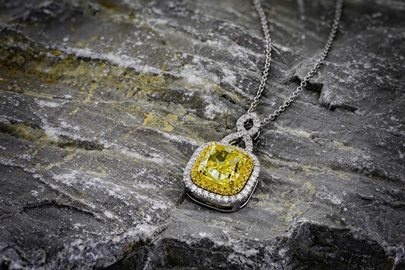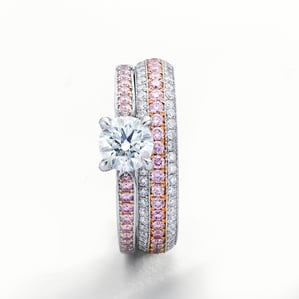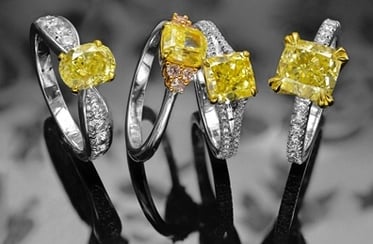
The diamond and gemstone industry is somewhat of an enigma. On one hand it is all about keeping up with the latest fashions and trends, yet on the other hand, its product is stones that have been on this planet since ancient times.
While diamonds, sapphires, emeralds, rubies and the various semi-precious gemstones have been worn and appreciated by different civilizations for centuries upon centuries, now ancient natural fancy color diamonds are coming into demand. So much so that many of the biggest jewelry companies, like Zales, Tiffany & Co., and Blue Nile have started heavily increasing their yellow diamond collections over the past year.
Colored diamonds were reintroduced about two decades ago and have increased in popularity tremendously ever since. Consumers and diamond collectors discovered the many advantages of these rare and stunning stones, partially due to their dwindling supply. Famous celebrities such as Jennifer Lopez, who was given a beautiful pink diamond engagement ring by then fiancé Ben Affleck, added to the popularity and demand of these magnificent gems.
As a diamond retailer, it’s important to take into account the significant differences between fancy color diamonds and their colorless counterparts, when using them in a jewelry piece. Here are some things to consider:
It’s All About the Color

The first thing to really understand about natural fancy color diamonds is that just as their name implies, these stones are truly all about the color. This means that although other important diamond factors such as the carat size, clarity grade, and the cut are extremely important, the color of the stone is what is looked at and noticed first and foremost. A natural fancy color diamond’s color is graded based on its color and color intensity level. The color, color combination, saturation, tone, and intensity are all elements to consider when purchasing a color diamond.
Jewelers also consider the stone’s color when deciding on a suitable setting. Unlike colorless diamonds, which are cut in a way that will allow light to enter and exit the stone as quickly as possible in order to create the ideal diamond shine and brilliance, color diamonds are cut so that the light reflects off of as many facets as possible and remains within the stone so that the color can be shown as clearly as possible.
Since promoting the color when setting one of these stones in a jewelry piece is so important, there are other 'tricks of the trade' that are often used. For example, when setting a colored stone many use a basket under the stone, which helps to show off the stone’s color. The metal color of the basket of course must be similar to the stone in order to allow that color to shine through. Regardless of the metal type used in the ring (rose gold, yellow gold, platinum), the prongs are chosen in a similar fashion to match the color of the stone. For instance, if you were mounting a yellow diamond, yellow gold would be used for underneath the stone and for the prongs. Similarly, rose gold would be ideal for pink diamond settings regardless of the design of the ring as a whole.
Often when constructing a colored diamond ring, a reflector is used. Similar to a basket that is placed under a center stone, the reflector can even run along the shank, underneath colored melee, to maximize the color saturation of the diamonds used.
Color Diamond Ring Styles

Since color diamonds are all about showing off their color, their shapes and their rings styles are chosen based on the ability to highlight this. While round diamonds are the preferred shape for colorless diamonds, since it is the best way to display the stone’s brilliance, cushion and radiant stones are the ideal shapes for natural fancy color diamonds because they show the diamond’s natural colors best.
Jewelers will look for styles and designs that highlight the color as much as possible. One way of achieving this is by using contrasting colors within the design. This can be done through contrasting metal colors and diamond colors, three stone rings of different colors, or by using halos with contrasting diamond colors. If a ring is created with a halo setting, more often than not, jewelers will choose to create a halo of diamonds surrounding the center stone that are of the exact same color and color intensity. Sometimes a stronger color is used to create the effect of a stronger color intensity, but in both cases, the result is the appearance of a more intense and prominent color diamond.
The most popular ring styles are Solitaire, Halo, Three Stone, or Side Stone rings. Obviously, each design incorporates hundreds of different variations.
Remember that the customer is always right, so although your recommendation as a professional jeweler is welcome if someone makes a special order, the design should be made according to their wishes.
The Real Deal
As often happens with successful items, replicas of natural fancy color diamonds are being sold all around the world. While they may be cheaper alternatives to the real deal, there is no comparison to the quality and beauty of a genuine diamond. More and more consumers are realizing this and demanding quality color diamonds, despite the higher prices. Notwithstanding the hefty costs, manufacturing natural fancy color diamonds is worth the while in the long run. For example, when it comes to cleaning or making a small repair on a ring, heat will not damage a natural stone in any way, though it could potentially offset the colors of artificial stones.
Bear in mind that designing and manufacturing color diamonds is quite different than the process for colorless stones. Even the most experienced manufacturers occasionally come across information they are unaware of. This is why accumulating every bit of information regarding these remarkable stones can be extremely beneficial for anyone looking into fancy color diamonds and fancy color diamond jewelry.


 RapNet Blog
RapNet Blog





